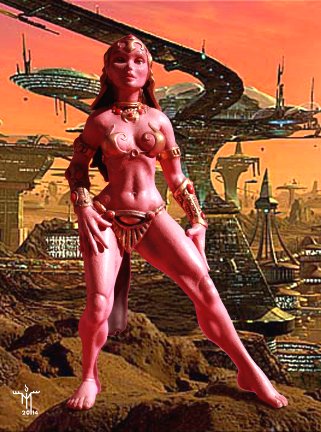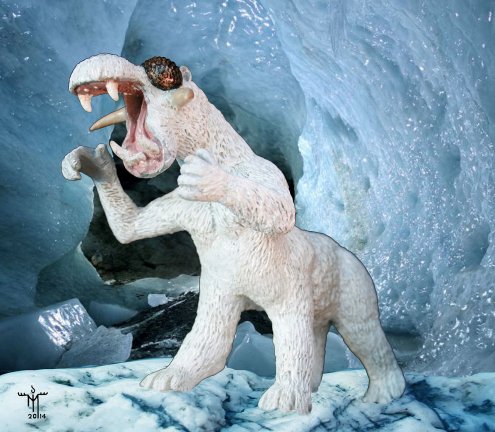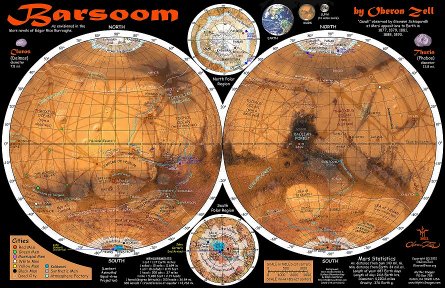Burroughs did a remarkable job of retaining consistency and continuity throughout the entire 11-book saga of John Carter’s (and others) adventures on Barsoom from 1866-1940. It is a bit disconcerting, therefore, to encounter the occasional inexplicable anomaly. 
Official Edgar Rice Burroughs Tribute and Weekly Webzine Site
Since 1996 ~ Over 15,000 Web Pages in Archive
Presents
Volume 5110
Anomalies in the Barsoom Paradigm
Part I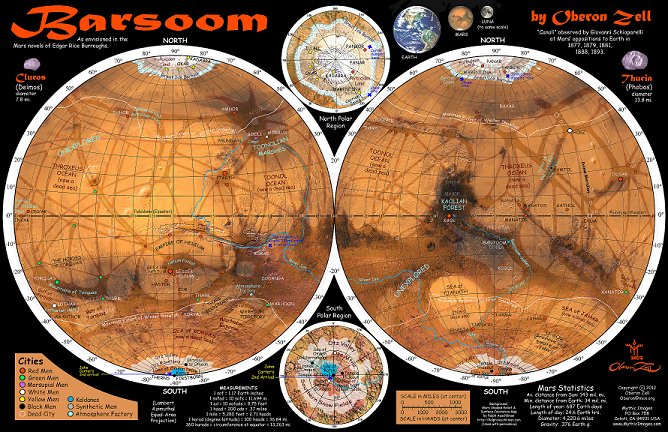
Larger | Largest (300 dpi)
(and possible solutions)
By Oberon Zell
Introduction(As an aside, it is interesting to note that the year John Carter was first transported to Mars (1866) was the same year that French Prof. Arronax, his aide Conseil, and American harpooner Ned Land were taken aboard Captain Nemo’s submarine Nautilus for a grand adventure in which they eventually traveled 20,000 leagues under the sea. 1866 was a good year for sci-fi adventures!)
Weird Science
[Steve Warner, personal correspondence, 12/30/13] ERB's Martian novels contain a good degree of science not founded in currently accepted fact. We can agree that ERB did the best he could with the knowledge of his time, and was focused more on telling a good story than scientific accuracy. Some of the questionable items he includes are:• Life as we know it on a habitable Mars!
• The 8th and 9th rays for aircraft buoyancy and atmosphere production, respectively.
• “Radium” as the component of proximity-detecting guidance systems, explosive projectiles and lighting.
• An astonishing range of more than four-limbed body plans.
• Climates and ecosystems that simply don’t match up with our current knowledge of Mars.
• Storage of the sun's rays for various purposes.
• A general timeline for civilization that goes back a million years or so.
• No mention of climate, weather, or seasons, other than hot days and cold nights.Breasts and eggs
Part I: Barsoomian Biology
She [Dejah Thoris] was as destitute of clothes as the green Martians who accompanied her; indeed, save for her delicately wrought ornaments she was entirely naked, nor could any apparel have enhanced the beauty of her perfect and symmetrical figure.1The first major anomaly, which we note immediately upon meeting the incomparable Dejah Thoris, is trying to reconcile the oviparous nature of the Martian humans with the lovely mammary glands prominently displayed by the virtually naked females (Dejah Thoris, Thuvia, Tara, Llana…)—although the breasts of Tavia in Fighting Man of Mars are evidently less obvious, allowing her to pass as a young man in harness:Regarding Tan Hadron’s flight through U-Gor, he tells that “At first, I think the fellow facing Tavia did not realize that she was a woman” (FMM/15). Even though the sentence goes on to say that “the scant harness of Barsoom hides little and certainly did not hide the rounded contours of Tavia’s girlish body,” it still suggests that her harness (which was that of a man, incidentally) at least initially hid her femininity.2It is stated in A Princess of Mars that the incubation period for human (and green men) hatchlings is an astonishing five Martian years (i.e. 9.4 Earth years), and that they therefore emerge from the egg as 9½-year-old youngsters (in Earth years), certainly well beyond the age of nursing.In a golden incubator upon the roof of our palace lay a snow-white egg. For nearly five years ten soldiers of the jeddaks Guard had constantly stood over it, and not a day passed when I was in the city that Dejah Thoris and I did not stand hand in hand before our little shrine planning for the future, then the delicate shell should break.3Since the fundamental purpose of mammary glands (other than decorative) is to provide milk for nursing infants, the obvious question is, why would the oviparous women of Mars have them at all?The only reasonable answer is that the Martian humans weren’t always egg-layers, but that their ancestors bore live babies and nursed them just as on Earth. Therefore we must postulate that oviparity in humans was induced via genetic modification at some point in history. Steve Warner comments on this anomaly, and proposes an amusing analogy:
Recall my thesis that the [Martian] humans were formerly viviparous, and that some biological engineering was done to switch over to an oviparous lifestyle to survive the collapse. Well, you would probably want to change as little as possible so as to maintain interest between the boys and girls. Thus, mammary glands and other sexual characteristics wouldn’t be changed. Also, fat is an excellent water storage mechanism – consider the camel.4Indigenous humans on MarsIndeed, humans on Mars themselves—who can interbreed with Earth humans—present perhaps the greatest anomaly of all. Vad Varo (Captain Ulysses Paxton) notes:
One animal which fits nowhere in this examination of the flora and fauna of Barsoom, is man. Upon every planet within the range the telescopes of Barsoomian scientists, I have seen men and manlike shapes. I cannot fathom this riddle and must concede to my old minister that the Creator created man in his own image and placed him upon all the worlds with life upon their surfaces.5Den Valdron addresses this riddle succinctly:…Burroughs Martians, except for some minor differences in coloration, which are mostly in the human range, generally appear to be fully human. That is, that a human being on Mars (two of them in fact... Ulysses Paxton and John Carter) are able to pass for Martians with very little notice. This suggests that Martians, at least as far as their exterior anatomy goes, are identical to humans, or well within human ranges. That’s a hell of a coincidence.One reasonable way to reconcile this anomaly is to postulate that the original stock of Barsoomian humans may have been transplanted from Earth in the distant past by another alien race who had space travel, such as the Morgors of Sasoom (“Skeleton Men of Jupiter”). We will explore this question further in Part III of this article.
And it seems to be a recurring coincidence. On Barsoom’s moon, Thuria, there are the Tarids, yet another human identical race. Human identical races also appear on Carson’s Venus, as well as on Earth’s Moon, and even on Jupiter. Hell, there’s even a human-identical race beyond the farthest star, in a system called Poloda.
Not only are all these races human-identical, but we also find that all humans are sexually compatible. There are interplanetary romances on Mars, the Moon and Venus. In at least some of these romances, offspring occur. This in itself is bizarre; one would imagine that a human from Earth would have more in common genetically with a Christmas tree than an extraterrestrial. The fact that hybrids can exist suggests a common genetic stock.
So then we must ask ourselves if indeed there is a common root race, and that all the interplanetary races are actually the same species? If so, how did they get out all over the place?6And then to try and factor in the evolution of a marsupial race of humans, who appear to be kangaroos from the waist down—it really boggles the imagination. So how to account for Goolies—presumably having evolved and lived their entire history on their tiny island of Ompt in the Toonol Ocean/Great Toonolian Marsh? All I can think to do is just regard them as an anomalous mutation. And I suppose that evolving pouches in which to carry their eggs to term is really no stranger than being egg-laying humans in the first place. In any case, the Goolies seem to be completely irrelevant to the history and areography of Barsoom, as they evidently have no contact or connection with the outer world other than the one brief encounter in Synthetic Men. Like the rocs (elephant birds) of Madagascar; the dragons of Komodo; the orangutans of Borneo; and the Hobbits of Flores.
It's difficult enough to reconcile the humans of Barsoom being identical to Earthlings in every way—including races and sexual/breeding compatibility—and then having them be egg-layers like monotremes, whose infants somehow grow over several years (nearly 10 Earth years in the case of Carthoris) through full childhood inside the eggs (which grow larger and larger to accommodate them).7
This oviviparity raises really difficult questions: Where do the infants get the water and nutrients to sustain that growth while sealed in the egg? How can a shelled egg grow larger? Where do the materials come from, and how are they assimilated? Moreover, as anyone who has changed diapers knows, bodily wastes and the associated toxic fumes would accumulate catastrophically! The eggs of oviparous creatures cannot grow larger once they are laid; they contain a large yolk sac that the embryo absorbs as it grows, until the soon-to-be hatchling has used up all the yolk and occupies the full volume of the egg. Only then it is ready to hatch. An incubation period of 9½ Earth years just seems inconceivable (pun intended). I can offer no solution to this anomaly.
Silks, furs and feathers
In A Princess of Mars, John Carter describes the procession of Tharks from Korad to Thark as carrying a multi-colored profusion of “magnificent silks, furs and feathers:”
The gleaming metal and jewels of the gorgeous ornaments of the men and women, duplicated in the trappings of the zitidars and thoats, and interspersed with the flashing colors of magnificent silks and furs and feathers, lent a barbaric splendor to the caravan which would have turned an East Indian potentate green with envy.8And every time sleeping accommodations and bedding are mentioned, they are referred to by the exact same phrase: “sleeping silks and furs.” Leather (from thoats?) is occasionally mentioned for harnesses and riding tack, but no other pliable materials; in particular, no woven cloth or other fabric of any sort. The obvious question is, where do these “silks, furs and feathers” come from? For virtually every Martian to have “sleeping silks and furs” requires a significant source and commercial trade in those items!There is no mention of silkworms on Barsoom—indeed, no bugs or insects of any sort,9 other than the enormous wasp-like siths of the Kaolian Forest. The only creatures mentioned in the Chronicles as sources of silk are the giant 12-legged “spiders” of the Hohr Valley whose webs provide fabric for the sinister citadel of Ghasta, in A Fighting Man of Mars. With poisonous fangs and twelve legs that grow upwards from their backs, the Hohr spiders hang from gossamer webs; if dislodged, they lie helpless on the ground, legs waving futilely. Their fine and immensely strong webbing is woven into ropes, clothing, tapestries, bedsheets—and even airtight cloth for a large hot-air balloon:
[Tan Hadron of Hastor] As we started to move through the vegetation we became aware of thin threads of a gossamer-like substance festooned from tree to tree and bush to bush. So fine as to be almost invisible, they were yet so strong as to impede our progress. It was surprisingly difficult to break them, and when there were a dozen or more at a time barring our way, we found it necessary to use our daggers to cut a way through them. 10But can we then accept that ghastly Ghasta enjoys significant commerce in their unique silks with the rest of the planet, as China did on Earth for centuries? The text refutes that possibility:[Tan Hadron of Hastor] Here, as in other parts of the palace, the wall coverings were of the gossamer-like silver fabric that had attracted my attention and admiration the moment that I had entered the building, and so fascinated was I by it that I could not refrain from mentioning it to the girl who sat at my right…
“Of what is it woven?” I asked.
“When you entered the valley Hohr,” she said, “you saw a beautiful forest, running down to the banks of the river Syl. Doubtless you saw fruit in the forest, and being hungry, you sought to gather it, but you were set upon by huge spiders that sped along silver threads, finer than a woman’s hair.”
“Yes,” I said, “that is just what happened.”
“It is from this web, spun by those hideous spiders, that we weave our fabric. It is as strong as leather and as enduring as the rocks of which Ghasta is built.”11“There is no such fabric anywhere else in Barsoom,” she said. “It is made here and only here.”What a tangled web!
“It is very beautiful,” I said. “Other nations would pay well for it.”
“If we could get it to them,” she said, “but we have no intercourse with the world above us.”12Then there are the furs. In Warlord of Mars, John Carter states that the white-furred apts of the arctic ice fields (the six-limbed Barsoomian equivalent of polar bears) are “the only true mammals on all of Barsoom.”13 Evidently Carter considers “mammals” to be defined by hair rather than mammary glands—though why white apes, banths, orluks, and even humans (all of which have hair on their heads, if nowhere else; and humans, at least, have mammary glands) don’t thereby qualify as “true mammals” is unclear. In Warlord of Mars, John Carter also mentions the Orluk, a huge fur-bearing arctic beast, much prized by hunters for its black-and-yellow-striped pelt. It is described as an “elephantine beast of prey.”14 Since orluks are, like apts, “fur-bearing,” I don’t know why Carter does not consider them also to be “true mammals.” Indeed, Carter specifically refers to sleeping wrapped in orluk furs: “Our warm orluk skins kept us perfectly comfortable, and it was only after a most refreshing sleep that we awoke shortly after daylight on the following morning.”15
But while apts and orluks are hunted for their furs by the Okarians and other inhabitants of the “Forbidden Land” within the Arctic ice cap, these peoples are isolated from the rest of the planet; nor does there seem to be an outside trade involving apt or orluk hunters and trappers. As these two Arctic animals are specified as the only fur-bearing beasts on Barsoom, how are all the Martians planetwide supplied with those sleeping furs? It’s an apt question indeed!
Which brings us to feathers. In POM, John Carter notes that there are no “destroying birds” in the agricultural regions of Barsoom.16 But in Gods of Mars, Carter discovers “brilliant, voiceless birds” in the Valley Dor at the South Pole. They are winged and bird-like, “but mortal eye ne’er rested on such odd, unearthly shapes.”17 Carter tells us that these Martian birds are brilliantly plumed and voiceless, but he doesn’t actually name or even describe any of them. However, much later, in Synthetic Men of Mars, we learn that one giant species of birds—the malagor—is large enough to carry several humans in flight. It was long believed to be extinct, until it was discovered by Ras Thavas in the Great Toonolian Marshes and domesticated for aerial transport.18 Ras Thavas was able to accumulate more than 500 of these birds for the synthetic Hormad in the city of Morbus. When the Hormad Pew Mogel left Morbus he took hundreds of these ginormous malagors with him as an aerial armada for his mad scheme to conquer Barsoom.19 Certainly these could provide feathers (and drumsticks!) enough for everyone, but since they were apparently unknown until they make their appearance late in the saga (1938-'39), it's hard to see how their feathers could have been commonplace in earlier times.
Red Vegetation and Blood
Another thing to consider is that originally the vegetation of Mars was presumably green for photosynthesis. But in the time of John Carter, most of it is now red (with some blue in the Valley Dor around the south polar Sea of Korus). What makes chlorophyll green and hemoglobin red is a difference of a single atom in their molecules: iron in hemoglobin and magnesium in chlorophyll. So the red vegetation of modern Barsoom would have “hemophyll” as its photosynthesizer—probably drawn from the abundant iron oxide in the soil. Blue vegetation might involve copper for “cyanophyll:”
While human blood is red, there are animals that have blue blood. Spiders, molluscs, lobsters, and certain other arthropods use hemocyanin in their hemolymph, which is analogous to our blood. This copper-based pigment is blue. Although it changes color when it is oxygenated, hemolymph typically functions in nutrient transport rather than gas exchange.20As an aside, in the movie, John Carter, when Martian blood is shed in battles scenes, it is shown as blue—whether from red men, green men, or even white apes. But this is erroneous; in the novels, except for the plant men, Martian blood is invariably described as being as red as our own:POM: “I sought out Dejah Thoris in the throng of departing chariots, but she turned her shoulder to me, and I could see the red blood mount to her cheek.”21GOM: “Great tails lashed in frenzied anger about us, razor-like talons cut our limbs and bodies, and a green and sticky syrup, such as oozes from a crushed caterpillar, smeared us from head to foot, for every cut and thrust of our longswords” (green for plant men)22
GOM: “To right and left flew my shimmering blade, now green with the sticky juice of a plant man, now red with the crimson blood of a great white ape;”23
GOM: “A dagger snatched from the harness of her mistress was waved aloft by some fair slave, its shimmering blade crimson with the lifeblood of its owner; swords plucked from the bodies of the dead about them;” (First Born)24
WOM: “Their eyes rested for a moment, wide in horror, upon the dead body of Salensus Oll, upon the blood that crimsoned the floor,” (yellow men)25
FMOM: “It tried to defend itself with its tail and talons, but we were too quick for it and presently it was lying in a pool of its own purple blood in the final spasmodic muscular reaction of dissolution.” (giant reptile with purple blood)26
LOG: “For a moment my amazing advent threw them all off their guard, and in that moment I leaped to the side of the red man and faced his remaining foes, the red blood of a green warrior dripping from my point.”27
1. Edgar Rice Burroughs, A Princess of Mars, © 1912 Frank A. Munsey Co.; Ballantine Books, 1963. ch. 8, p. 36. 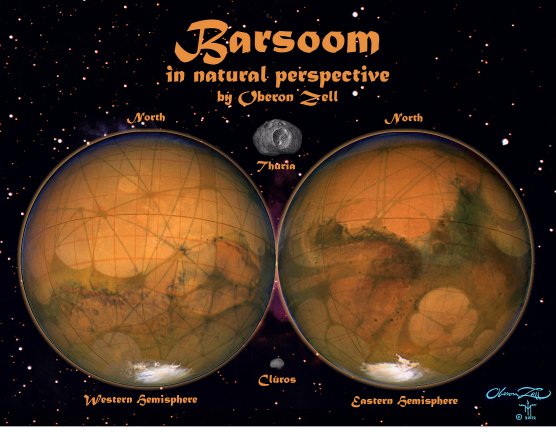
Anomalies of Barsoom Footnotes for Part I
2. Fredrik Ekman, “Dressed to Kill,” ERBzine Volume 0438 http://www.erbzine.com/mag4/0438.html
3. A Princess of Mars, op cit. ch. 27, p. 140.
4. Vad Varo (Captain Ulysses Paxton), “Thoughts on the Evolution of Current Day Flora and Fauna of Barsoom,” ERBzine Volume 1499 http://www.erbzine.com/mag14/1499.html
5. Steve Warner, personal correspondence with Oberon Zell, 12/30/13
6. Den Valdron, “Are the Barsoom Inhabitants Human?” (Part of the Exploring Barsoom Series) ERBzine Volume 1418 http://www.erbzine.com/mag14/1418.html
7. A Princess of Mars, op cit. (“…like all green Martian eggs, they would grow during the five-year period of incubation until they obtained the size of those I had seen hatching on the day of my arrival on Barsoom.”) ch. 14, p. 67.
8. A Princess of Mars, op cit. ch. 15, p. 71.
9. A Princess of Mars, op cit. (“The crops on Mars are always uniform, for there are no droughts, no rains, no high winds, and no insects, or destroying birds.”) ch. 21, p. 105.
10. Burroughs, A Fighting Man of Mars, © 1964; SFBC Science Fiction Printing 2006 (spiders of Hohr Valley; Hadron of Hastor) ch.7, p. 227-228
11. Ibid. ch. 8, pp. 235-36.
12. Ibid. ch. 8, p. 235
13. Burroughs, Llana of Gathol, Kindle Edition (white-furred apts as “the only true mammals on all of Barsoom”) book 3, ch. 11.
14. Burroughs, Warlord of Mars, Grosset & Dunlap, 1919 (orluk described as an “elephantine beast of prey” with “magnificent fur” consisting of a “black and yellow striped hide”) ch. 8, p. 157; ch. 9.
15. Ibid. (sleeping in “warm orluk skins”) ch. 9, p. 169.
16. A Princess of Mars, op cit. (“…there are no … destroying birds.”) ch. 21, p. 105.
17. Burroughs, The Gods of Mars, © 1912, 1913; Nelson Doubleday edition, 1971 (“I lay upon a close-cropped sward of red grasslike vegetation, and about me stretched a grove of strange and beautiful trees, covered with huge and gorgeous blossoms and filled with brilliant, voiceless birds. I call them birds since they were winged, but mortal eye ne’er rested on such odd, unearthly shapes.”) ch. 1, p. 2.
18. Burroughs, Synthetic Men of Mars, © 1940; SFBC Science Fiction Printing 2006 (malagors discovered by mad scientist Ras Thavas and domesticated for aerial transport) ch. 3, p. 423-ff.
19. Burroughs, The Giant of Mars, Canaveral Press, Inc., 1964; Ballantine Books, 1965 (thousands of malagors are pressed into service by mad scientist Pew Mogel as a dreadful aerial assault force on Helium) ch. 7.
20. http://www.About.com-Chemistry
21. A Princess of Mars, op cit. ch. 14, p. 64.
22. The Gods of Mars, op cit. ch. 1, p. 9
23. Ibid. ch. 2, p. 16
24. Ibid. ch. 11, p. 100
25. Warlord of Mars, op cit. ch. 14, p. 258
26. Burroughs, A Fighting Man of Mars, © 1930; Nelson Doubleday edition 1973, ch. 8, p. 234
27. Burroughs, Llana of Gathol, Kindle Edition. pp. 125-126.
